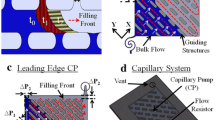Abstract
In this paper, we report the improvement of PCR microfluidic chip efficiency achieved by coating the inner surface of steel capillary microchannel with a 22-µm film of the ultraviolet-solidified NOA61 using a device invented by us. Our results indicate that with this treatment, the roughness of the inside wall of steel capillary was improved from Ra = 0.921 to Ra = 0.254. The contact angle was decreased from about 95° to 56°, and the surface hydrophobicity was also increased. The flow pressure for performing the real-time PCR in the microfluidic chip with modified surface was reduced by twofold (2.11/1) and that resulted in a substantially increased efficiency of PCR. A modification of the microchannel interior surface improved the quality of the on-chip integrated PCR procedure.








Similar content being viewed by others
References
Manz, A., Graber, N., & Widmer, H. M. (1990). Miniaturized total chemical-analysis systems: A novel concept for chemical Sensing. Sensors and Actuators B: Chemical, 1(1–6), 244–248.
Manz, A., Harrison, D. J., Verpoorte, E., et al. (1993). Planar chip technology of separation system: A developing perspective in chemical monitoring. Advances in Chromatography, 33, 1–66.
Shameli, S. M., et al. (2011). Fully integrated PDMS/SU-8/quartz microfluidic chip with a novel macroporous poly dimethylsiloxane (PDMS) membrane for isoelectric focusing of proteins using whole-channel imaging detection. Electrophoresis, 32(3-4), 333–339.
Wu, J., Kodzius, R., Cao, W., & Wen, W. (2013). Extraction, amplification and detection of DNA in microfluidic chip-based assays. Microchimica Acta. doi:10.1007/s00604-013-1140-2.
Nagai, H., Murakami, Y., Morita, Y., et al. (2001). Development of a microchamber array for picoliter PCR. Analytical Chemistry, 73, 1043–1047.
Kopp, M. U., de Mello, A. J., Manz, A., et al. (1998). Chemical amplification: Continuous-flow PCR on a chip. Science, 280, 1046–1048.
Chiou, J., Matsudaira, P., Sonin, A., et al. (2001). A closed-cycle capillary polymerase chain reaction machine. Analytical Chemistry, 73, 2018–2021.
Sun, K., Yamaguchi, A., Ishida, Y., et al. (2002). A heater-integrated transparent microchannel chip for continuous-flow PCR. Sensors and Actuators B: Chemical Sensors and Materials, 84, 283–289.
Obeid, P. J., & Christopoulos, T. K. (2003). Continuous-flow DNA and RNA amplification chip combined with laser-induced fluorescence detection. Analytica Chimica Acta, 494, 1–9.
Iliescu, C., et al. (2012). A practical guide for the fabrication of microfluidic devices using glass and silicon. Biomicrofluidics, 6(1), 016505.
Fu, L.-M., et al. (2013). Rapid prototyping of glass-based microfluidic chips utilizing two-pass defocused CO2 laser beam method. Microfluid Nanofluidics, 14(3-4), 479–487.
Fukuba, T., Yamamoto, T., Naganuma, T., et al. (2004). Microfabricated flow-through devices for DNA amplification-towards in situ gene analysis. Chemical Engineering Journal, 101, 151–156.
Polini, A., Mele, E., Sciancalepore, A. G., Girardo, S., Biasco, A., Camposeo, A., et al. (2010). Reduction of water evaporation in polymerase chain reaction microfluidic devices based on oscillating-flow. Biomicrofluidics, 4(3), 036502. doi:10.1063/1.3481776.
Ramalingam, N., San, T. C., Kai, T. J., Mak, M. Y. M., & Gong, H. Q. (2009). Microfluidic devices harboring unsealed reactors for real-time isothermal helicase-dependent amplification. Microfluid Nanofluidics, 7(3), 325–336.
Liying, Y., et al. (2005). Micro flow-through PCR in a PMMA chip fabricated by KrF excimer laser. Biomedical Microdevices, 7(3), 253–257.
Heng, Q., et al. (2009). Fabrication and characterization of a polymethyl methacrylate continuous-flow PCR microfluidic chip using CO2 laser ablation. Microsystem Technologies, 15(7), 1027–1030.
Heng, Q., et al. (2008). Hydrophilicity modification of poly (methyl methacrylate) by excimer laser ablation and irradiation. Microfluid Nanofluidics, 5(1), 139–143.
Wagli, P., Homsy, A., & de Rooij, N. F. (2011). Norland optical adhesive (NOA81) microchannels with adjustable wetting behavior and high chemical resistance against a range of mid-infrared-transparent organic solvents. Sensors and Actuators B: Chemical, 156, 994–1001.
Dupont, E. P., Luisier, R., & Gijs, M. A. M. (2010). NOA 63 as a UV-curable material for fabrication of microfluidic channels with native hydrophilicity. Microelectronic Engineering, 87, 1253–1255.
Arayanarakool, R., Le Gac, S., & van den Berg, A. (2010). Low-temperature, simple and fast integration technique of microfluidic chips by using a UV-curable adhesive. Lab on a Chip, 10, 2115–2121.
Sollier, E., Murray, C., Maoddi, P., & Di Carlo, D. (2011). Rapid prototyping polymers for microfluidic devices and high pressure injections. Lab on a Chip, 11, 3752–3765.
Mokkapati, VRSS, Bethge O, Hainberger, R. 2012. Microfluidic chips fabrication from UV curable adhesives for heterogeneous integration. In 62nd IEEE electronic components and technology conference (ECTC) (pp. 1965–1969).
Zhang, C., & Xing, D. (2007). Miniaturized PCR chips for nucleic acid amplification and analysis: Latest advances and future trends. Nucleic Acids Research, 35(13), 4223–4237.
Acknowledgments
This project was supported by the National Natural Science Foundation of China (Grant No. 51375024), Scientific-technical project of Beijing Education Committee (Grant No. KZ201210005009), and the opening foundation of the State Key Laboratory of Space Medicine Fundamentals and Application, Chinese Astronaut Research and Training Center (Grant No. SMFA13K06).
Author information
Authors and Affiliations
Corresponding author
Rights and permissions
About this article
Cite this article
Wu, J., Guo, W., Wang, C. et al. Research to Improve the Efficiency of Double Stereo PCR Microfluidic Chip by Passivating the Inner Surface of Steel Capillary with NOA61. Cell Biochem Biophys 72, 605–610 (2015). https://doi.org/10.1007/s12013-014-0508-1
Published:
Issue Date:
DOI: https://doi.org/10.1007/s12013-014-0508-1




